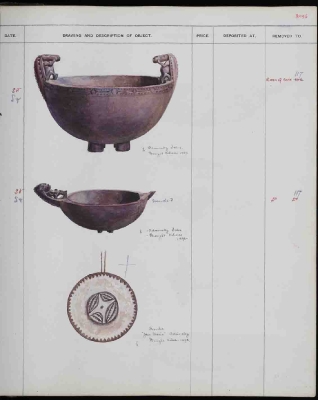To search the RPR site click here
How many individuals and institutions were associated with the objects in the Pitt-Rivers' collections?
A total of 913 institutions and individuals are known, at this juncture, to have been associated with all the objects collected by Pitt-Rivers from 1827 to 1900, all of whom are listed in the People section of this website. They are associated as makers, field collectors, previous owners or sources (sometimes they have been associated in all these ways).
A total of 275 individuals and institutions are thought to be associated with the founding collection only. This number is much smaller than the number known to be associated with the collection he formed after 1880. This is largely due to the better documentation of the second collection, as the first has very little information about provenance or source, or previous owners, field collectors or makers. Of course each object from the founding collection will have had a number of individuals associated with it; it is just that in most cases we do not know who they were. In a very small number of instances where better documentation about the object exists elsewhere (for example, with a proven previous owner) then we can improve and add such data, but in most cases we must assume this data is now lost. To see a further breakdown of the figures see the detailed breakdown here (report to follow).
A total of 40 individuals and institutions are known to have been associated with objects from both the founding collection and the Pitt-Rivers collection after 1880. This is quite a small number but, again, might reflect the relative lack of data about the provenance of the founding collection. Because so many of his objects were obtained from dealers or institutions they are likely to have changed over the fifty years or so that he collected (from circa 1850 until his death in 1900). The fact that any dealer or individual contributed to both collections suggests a closer relationship between them and Pitt-Rivers, though this might not be true.
A total of 598 individuals and institutions are known to have been associated with the second collection. This is by far the most individuals known to have been associated with any one part of his collection. The high number reflects the good documentation processes that Pitt-Rivers instituted after 1880. To see a further breakdown of the figures see the detailed breakdown here (report to follow).
Note that as regards this part of his collection, it is sometimes hard to distinguish between individuals and institutions as so many of his artefacts were obtained from dealers. I have taken the line that when an individual dealer is named they count as an individual but when a company only is named then it is counted as an institution. These figures, therefore, are flawed as this distinction is not particularly meaningful. In any case confusion in whether an individual is a collector / donor or a dealer may reflect the nineteenth century blurring of these roles. As Yallop says:
It was not necessarily unusual as this time for the distinction between collector and dealer to appear hazy. Dealers could end up amassing far more stock than they could sell, and so metamorphosed into collectors; the lively and extensive interaction between collectors meant that it was common for prized objects to exchange hands between them.' [2011: 98]
If you know any more about any of the individuals or institutions mentioned in this list please send details to This email address is being protected from spambots. You need JavaScript enabled to view it.
AP, 20 May 2010




